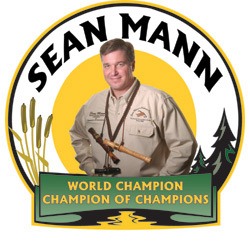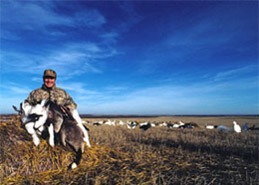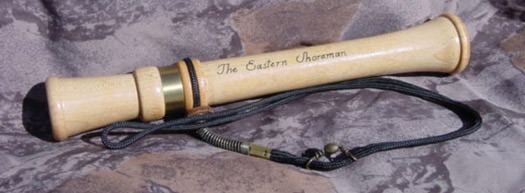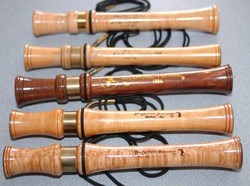Sean Mann Outdoors – Generations Ahead of the Competition.
Over 34 Years of Quality Duck and Goose Calls.
Our Story…
There is hardly a serious waterfowler alive who has not heard of Chesapeake Bay or of Maryland’s Eastern Shore. The area is home to a waterfowling tradition that, like our nation itself, is over 200 years old.
Before Arkansas and Illinois existed Maryland’s waterfowling tradition was in full swing. At first Canvasbacks were the primary quarry for the colonial markets of Washington, Baltimore, Richmond, Philadelphia, New York, and Boston. As market gunning was outlawed professional waterfowlers began to entertain “sports”, wealthy patrons from the nearby cities, who came to the area to indulge their wing-shooting fantasies on the bountiful game of the Chesapeake region. These were the earliest known guides in America.
As time passed the Canada Goose replaced the Canvasback as “king quarry” in this area. Guides raised flocks of Geese for live decoys, “callers” were birds that were staked to the ground in a given location, “flyers” actually went out to passing flocks and brought them back to the sports guns. Eventually, these live decoys were also outlawed. To many of us the day live decoys were outlawed marks the first day of modern waterfowling.
Here on “the Shore”, Geese became more prevalent due to many of the same influences that have allowed deer populations to explode. First, farming became more mechanized through the use of powered machinery, then farming became more widespread as similar machinery allowed land to be cleared for Agricultural use. As this was all underway, the Eastern Shore’s broiler (chicken) industry was expanding at a rate that eclipsed its’ ability to produce grain. The need for grain drove the need for agricultural land which created more and more habitat for geese (and deer).
 The wintering goose populations on the Eastern Shore grew at an alarming rate and access to the area became simpler through better bridge and road systems. Situated within a three hour drive of a full 30% of the United States population, the area was a natural destination for serious hunters, and the “market-gunners now guides” were properly set up to handle their clients.
The wintering goose populations on the Eastern Shore grew at an alarming rate and access to the area became simpler through better bridge and road systems. Situated within a three hour drive of a full 30% of the United States population, the area was a natural destination for serious hunters, and the “market-gunners now guides” were properly set up to handle their clients.
I grew up in Easton, a town known as the “Colonial Capitol of the Eastern Shore”. Easton is located in the center of the Delmarva Peninsula, a spit of land between Chesapeake Bay and the Atlantic Ocean. As you might have guessed, it is made up of Delaware to the north, Maryland’s Eastern Shore in the middle, and Virginia’s Eastern Shore to the south. Delmarva is synonymous with waterfowl habitat, and it is a fact that every known waterfowl species on the North American continent has been harvested here at one time or another.
Easton is the most accessible geographically, of all of the colonial towns on the Eastern Shore. It is 6 miles from Oxford, home of Robert Morris one of the first to sign the Declaration of Independence. Mr. Morris’ Inn is still in operation today. A few miles in a slightly different direction is St. Michaels, “the town that fooled the British” during the war of 1812, and slightly beyond St. Michaels is Tilghman Island, part of a land grant that our first president gave to his right hand man Colonel Tench Tilghman. Cambridge, a significant colonial seaport and home to Blackwater National Wildlife Refuge is 15 miles south, while Chestertown, the town whose “Tea Party” pre-dated Boston’s is 40 minutes to the north.
At 4:00 a.m it takes 50 minutes to get to Easton from Washington, 75 minutes from Baltimore, 105 minutes from Philadelphia, 105 minutes from Richmond… You get the picture.
I started going hunting with my dad when I was about 5. When I was 7 he let me shoot a .410 and handed me one shell at a time “to make sure.” That year I watched as a charge of #4s actually connected with a goose that appeared out of the fog in response to my incessant monotone goose calling, while dad dozed off.
Then I realized that I was holding the gun! My first goose, and I was ruined for life!
I grew up the most fortunate recipient of my Dad’s-hobby-gone wild. “The Gun Shop” opened by William F. Mann was (and still is) located at 36 East Dover Street in Easton, right across the street from the Tidewater Inn.
 A typical Thursday night at the Gun Shop went like this; a chartered Greyhound-type bus would pull up in front of the store, its contents would empty into the store and buy guns, shells, licenses, boots, etc.. Then they would get back on the bus and go around the block only to pull up across the street in front of, you guessed it, the Tidewater Inn. Why ask why?
A typical Thursday night at the Gun Shop went like this; a chartered Greyhound-type bus would pull up in front of the store, its contents would empty into the store and buy guns, shells, licenses, boots, etc.. Then they would get back on the bus and go around the block only to pull up across the street in front of, you guessed it, the Tidewater Inn. Why ask why?
Often, while the guys from the bus were in the shop, their guides would show up and make recommendations regarding ammunition, guns, etc., and usually those guides would end up trying out the calls that we carried in the store. It was always amazing to me that the guides here got sounds out of the Olt and Faulks calls that dad and I had never heard on the instructional records that we would listen to at home, but that we always heard when we listened to birds.
I was about 8 when Dad opened the store. It wasn’t too far from school, and I would beg Mom and Dad to let me stay at the shop during the season, until Dad closed at 9:00 pm. If I convinced them that my homework was finished, they’d let me stay. I spent evenings in the shop until I graduated high school.
When I was a kid I was goose crazy! If we were going somewhere in Dad’s car, I’d worry him to no end whenever we saw geese. I would pester him until he pulled the car over and let me put his tape recorder out the window so we could capture the sounds of those birds, and use them in our practice at home. Every Saturday, and a few mornings during the week, Dad and I would hunt. Anybody who knows what that is like is a lucky person!
September of 1972 my dad had the first of a number of heart attacks. Hunting together came to a screeching halt.
While Dad was in the hospital, a classmate of mine, who also lived up the street from us, named Joe Walsh asked his dad if I could go along with them when they hunted. His dad agreed to let me go along. His name is Dr. Harry Walsh. Dr. Walsh had just finished a book on the market hunting days of the Chesapeake region called “The Outlaw Gunner”, and a few years earlier, in collaboration with Mr. Bill Perry had started an event called “Waterfowl Festival”. If you don’t already know it Waterfowl Festival is where the World Goose Calling Championship Contest is held. It is also where every Waterfowl artist, carver, and enthusiast worth his salt displays his craft.
Dad’s health got a little better, but his desire to shoot geese was pretty much gone, though he still enjoyed going hunting and calling birds. As time passed, he stopped renting farms because most of our customers at the store invited him along enough that the work and expense of renting didn’t make as much sense as it used to. The only problem with that as I saw it was that the “noisy kid” wasn’t getting the invitation, Dad was.
I started putting 1 and 1 together, then a bolt of inspiration hit me, “hey these guides get PAID to go hunting! What’s not-to-like about that?”
I went over to the brochure rack in the store and pulled out the one with the address closest to home on it, R.L. “Bunky” Ewing, Jr.. It also had more pictures of happy clients in it than some of the others, a bonus! I called Mr. Ewing and asked him if he had an apprenticeship program. He was kind enough not to laugh at me, and creative enough to create one on the spot. I was 14 at the time.
Bunky is quite a character. He always has been. The “training program” was actually quite a good thing. Of course, I never met any other students. It consisted of cleaning out blinds and pits, making and painting decoys, patching boats, and occasionally driving by the farms that the real guides hunted, while they hunted. A couple of times he even said, “bring your gun.”
Seriously though, I was allowed to hunt a few times with the other guides that year. What an eye-opener that was! Man could that crew call geese! My education had begun!
I listened and asked and learned and asked and listened and learned and asked, and cleaned out blinds and pits and painted decoys and patched boats, and asked and listened and watched and asked and learned. It’s a good thing too, because opening day the following year Bunky had so much business that he had to put me in the field with a client! It was a “Bull-Pen” assignment. The real guides would come and rescue us when they had gotten their limit.
I got lucky, the geese were friendly, we got our geese, the client was happy, and I was ruined for life because I had just been paid to take a person on a hunt!
I took a few groups for Mr. Ewing that year, usually when he was over-booked. As luck and the quality of Bunk’s farms would have it, we often got our birds, and always had a nice time. Next thing I knew, people were requesting me as their guide. Within a few years I was guiding every weekend, and taking the opening days off from school. I was in heaven!
Goose hunting, money, and days off from school; I still pinch myself over that!
Oh yeah, I still cleaned out blinds and pits, painted decoys, patched boats, etc., but as Bunky would say, “if you have these skills, you have to put them to use.” All the while I was learning to call geese the way Bunk and the boys did, because all of the work details were an opportunity for me to listen and ask and learn. Bunky is a “larger than life” character in this area, but what I can tell you is that the man was a patient teacher, a good boss, and he gave me opportunities that didn’t exist in the hunting industry for kids my age. I’ll never forget it, Mom will never forgive it! Let’s just say I wasn’t considering a career in medicine at this point…
That is pretty much how the rest of high school went. Start school a week after dove season opened, play soccer and get ready for goose season, goose season opens at the end of October, hunt until January 31, wait for next season…
When I graduated High School and went to College I scheduled my classes around the hunt schedule. In truth, hunting paid my college tuition for all four years.
My freshman year of College 1981 I was home for the Waterfowl Festival, it’s the second weekend in November each year. I stopped by the Gun Shop to see what was new and exciting. When I got there I met Bunky and a fellow guide named Bob Eaton. I asked them what they were up to and they said they were on their way to the call in the World Goose Calling Championship. The contest had been held in Easton for a few years by then, but I was always too busy to attend. I wanted to see what it was all about, so I asked the guys to wait for me. Dad said, “you should call in it.” I said “no way, I’ve never even heard a contest before!” Then he said, “I dare you.” Well, need I say more? A dare from Dad was never ignored.
We went over to the contest and I was blown away by the sounds I heard. Screaming duck calls, which I had never heard before, and goose calling that was all World Class. I wondered what I was doing there.
There were over 50 people in the first round of the World Goose Calling Contest. The field had to be narrowed to 6 which included the previous year’s World Champion. It took hours! We went through round one, and they called my name among those selected to continue. I thought, “What are they thinking?” We called in the second round and they called my name as one of the 5 people who would compete with the last year’s champion in the finals. I was, simply, floored. Later that evening in the finals I finished 4th place in the World Goose Calling Championship. To tell you the truth, I had no idea what I was doing, but after making the first cut, I just tried to duplicate what I had already done. Joe Bacon was the winner that year on an Olt 77.
Somehow, Glynn Scobey got my phone number and called me to congratulate me. He asked for my address and sent me a couple of calls. I started selling Glynn’s calls at local shows, and I offered him some design suggestions. But what does a College kid know about Goose Call design?
Dad sold the shop in 1982 after another serious heart attack and Quintuple By-Pass Surgery.
The next year I was fourth again. Dave Coleman was the winner on a Knight and Hale tube call. I was speaking with Jim Olt while ordering some calls from him, and offered the same design suggestions to him as I had to Glynn Scobey. Again, what does a College kid know about call design?
The year after that I climbed to third and Bill Privott was the winner using his own voice.
After the 1983 contest as I left the auditorium it was raining, sleeting snowing, just miserable outside! It must have been 10:00 p.m. and all of the shuttle buses for the Festival had stopped running at 9:00. There was a man walking down the street in this mess, and I pulled over and asked him if he would like a ride. He hopped right in and introduced himself as Dan Edwards. He told me where his car was and how much he had enjoyed the contest. He asked me if I would give calling lessons and asked for my phone number, which I gave him. I dropped him at his car and thought nothing else of it.
The following spring I graduated from Loyola College in Baltimore, Maryland. I went to work for a bank, First National Bank of Maryland, in a management training program. One day Dad called me and said that a Mr. Edwards was looking for me regarding teaching a calling course. I called Mr. Edwards and found out that he worked at a local College and had lobbied for and gotten approval for a Goose Calling course for me to teach! Un-believable! Now they want to pay me to teach people how to blow goose calls, and call me an Associate Professor to boot. Twilight Zone! It gets better…
I showed up to teach the course, and there were about 25 people signed up for this thing, and it was to run for 8 weeks. After the first class was over, Mr. Edwards (Dan) and I struck up a conversation about calls and call design. Little did I know, he was an industrial arts professor with access to the machine shop. We talked for hours that night and he told me if I had any call design ideas that I wanted to try that he would be happy to help.
The rest is pretty much history. Dan patiently helped me to bring all of the ideas into form on the lathe. Some I tossed out, some I stuck with. Ultimately, the prototype Eastern Shoreman took shape in that shop. Based on the fact that the other call makers were not interested in my earlier suggestions, I decided to keep this design to myself.

I took the prototype to the World Championship the following fall. After finishing in the top 4 for three years in a row with slightly modified versions of store-bought calls, I walked in with a contraption that was almost 11″ long, made from Purple Heart, and unlike anything anybody had ever seen before. Despite the ridicule of several of my competitors, I stuck to my belief that I could do well with this call.
Well, I did not make the finals. I did better than that! I made the first cut, but not the second. I guess the 2 routines that I blew were enough to convince my fellow guides that I was on to something.
The first result was that Harold Knight offered to buy the call and the right to produce it from me for a tidy sum. Now I thought I was on to something too. I told him I’d think about it.
 Next, my fellow competitors asked me how much the calls were. I said $100.00 each, expecting to hear, “yeah right!” What I heard was, “how do I get one?” I walked out of the auditorium that night with deposits for 25 orders for $100.00 goose calls during a time when you could buy any goose call for $10.00! In fact, the World Championship Goose Calling Contest only paid $500.00 to the winner!
Next, my fellow competitors asked me how much the calls were. I said $100.00 each, expecting to hear, “yeah right!” What I heard was, “how do I get one?” I walked out of the auditorium that night with deposits for 25 orders for $100.00 goose calls during a time when you could buy any goose call for $10.00! In fact, the World Championship Goose Calling Contest only paid $500.00 to the winner!
Well $2500. in orders was motivational, to say the least. My bank salary was $11,000.00.
I continued to teach the course, continued to refine my design, and continued to practice. In March of that year I won the Mid Atlantic Goose Calling Contest in Virginia Beach Virginia. That was the first contest I ever won. That was the day I met our photographer Dave Hagan.
In October and November of ’85 I was beginning to deliver the calls from the prior year’s orders, and I was getting orders weekly. I don’t know how people found me. They just did. Then, Tidewater Specialties, a local mail-order company put the calls in their catalog, and the orders were getting ridiculous. I had no shop training other than what Dan had shown me, had to figure out how to apply finish to these calls so that they wouldn’t fall apart, and had to figure out how to make them better and faster at the same time. After all, I still had a career at the bank to attend to.
Well November of 1985 things went crazy. I won the World Goose Calling Championship and was officially back-ordered for a full year with deposited orders. Then I won the Mid Atlantic again, then the World Championship again in 1986. The orders piled up higher and higher. Everyone in the family was helping somehow.
In the spring of 1987 I left the bank and went to work for a friend, and fellow goose hunter named Bill Sherertz. Bill is from Portland Oregon, and is the CEO of Barrett Business Services, Inc. a national Human Resources solutions firm. I began managing the Baltimore operation of his company in August of 1987.
In November of 1987 I was going for the first-ever three time in a row run in the Mason-Dixon and in the World Goose Calling Championship. I didn’t win either contest. No problem though, orders were still coming in at a rate I couldn’t keep up with. My brother Joseph came to work on calls shortly thereafter, and we started to make better headway on the orders.
The only problem was that guys all over the country were calling in more geese and winning contests with our calls. We persevered, however, and always worked on making the calls better, not faster. Joe was relentless in the pursuit of better finishes and designs to make the calls sound better, look better, and last longer.
People constantly asked me why I didn’t make calls and guide full-time. I thought that if I tried it, it wouldn’t be fun any longer. I’d have to turn out quantity and not quality.
The gentleman who molds and I were having a discussion one day, and he asked me why I didn’t mold the whole call. I said that I didn’t think we could achieve the sound that I wanted in a molded call. We wrestled about the idea for two years before he said, “if it doesn’t sound exactly like your best wooden model, you won’t have to pay me.
Not only did I pay him for the mold, but I won the World Goose Calling Champion of Champions contest blowing the first one that came out of the mold! That contest had Tim Grounds, Allan McCree, Dave Coleman, Keith McGowan and a bunch of other World Champions in it. I guess he molds a pretty good call.
We’ve brought out a variety of Canada Goose Calls, Duck Calls, Snow Goose Calls, Specklebelly calls and there are lots of new models to come. Every model has been designed by me, made by me, and ultimately tuned by me or one of our World Champion Pro Staffers; Three-Time World Champion Keith McGowan, or Two-Time World Champion Kevin Popo.
Keith McGowan, World Goose Calling Champion in 1987, 1989, and 1990 and I put our heads together on a call in 1994. Keith blew the prototype in the 1995 Champion of Champions contest. Interestingly, while Keith did not win, I did, his call and calling got the attention of Kevin Popo.
Kevin wanted a call like Keith’s prototype “Shorty”, and hounded me until he got one. He used the first version to win the World’s Championship in 2001. Then he used another variation of the “Shorty” to win again in 2002.
It would be impossible for me to thank everyone who has made a contribution to this organization along the way. You all know who you are, and I thank you from the bottom of my heart. (Each of you is entitled to a complimentary re-tune every 10 years whether you need it or not. Please include return shipping costs, and make sure it is one of our calls!)
To all of the hunters who have supported us throughout the years. Thank you. You are the reason we exist! Keep telling us what you want from us, and we’ll continue to do our best to deliver it. Please pass our tradition on to the next generation. Teach them to handle it with respect and love for the great outdoors and the game that we pursue.

